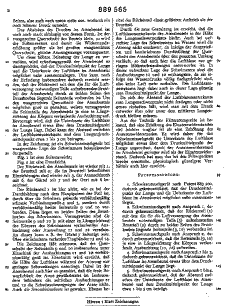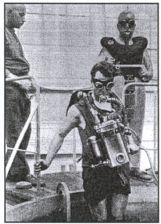|
|
|||||||
Für Harald B. von Janwillem Bechhttp://www.therebreathersite.nl The Dräger Gegenlunge
From Counterlung to Swimdive Device By Michel Jung, 1997 Edited from a translation by Joe Bauer
The article on Hans and Lotte Hass in issue 9 of Historical Diver prompted several questions regarding the construction and development of the “gegenlunge” (counterlung) build by the German firm Dräger of Lübeck several decades ago. Michael Jung, Historical Diver’s German Contributing Editor and author of the Hass article, now describes the development from “counterlung” to swimdive device in this short pictorial review
The “gegenlunge” or counterlung was so named because the air passes back and forth the divers lungs to the unit’s air bas as the diver breathes. Dräger’s Gegenlunge of 1929 (upper left) and the “Badetauchretter” (“Bathing-dive-rescue device”) of 1915(upper right) unlocked new applications for oxygen rebreathers. Since the device was very light, it was possible to use it for small underwater jobs such as the search and recovery of drowning victims. The diver was held down by heavy weights slung around his hips and neck, and he walked about on the sea floor in leather sandals. Both devices are shown being tested in Dräger’s dive basin, lower left, and the Bathing-dive-rescue device is seen in use (lower right).
A review of patents granted to Drägerwerk provides a guide to the evolution of the swimdive device from the original Gegenlunge. The origin of the unit is foun_d in Dräger's 1912 U-Boat escape apparatus. The company first developed the Bathing-dive-rescue device in 1915 and later introduced the Gegenlunge in 1928. It is recognizable by the ring-shaped breathing bag encircling the neck. The circular back was initially to facilitate an upright posture while walking on the seabed as well as to assure safe flotation at the surface when used as a rescue device. The Gegenlunge was patented on Dec 21, 1928 (German Pat. No. 529 399) In 1942 and 1943, there followed several patents which converted the Gegenlunge to a swimdive device, mainly by changing the air bag and equipping the diver with swim fins. Initially, the patent of June 16, 1942 (German Pat. No. 857 753) relocated the buoyant breathing bag onto the diver’s bag, to facilitate a proper swimming position. The apparatus could, as desired, be used for swimdiving or, if special weights were added, to walk on the seabed. This is the device which was used by Hans Hass during his Aegean expedition in the summer of 1942. The standard unit came with a normal automatic oxygen valve which supplied the diver with a steady volume of fresh oxygen. Hans modified his unit with a special demand-button ("Zuschuss knopf') which allowed for an increase in oxygen. If he over exerted himself or had to perform an emergency ascent, he could push this button and additional oxygen would flow into the breathing bag. Next followed a patent for a "swimdive device with self-contained air supply" on May 28, 1943 (German Pat. No. 883 100), on which the location of the breathing hoses and other attachments had a more streamlined arrangement. This was important in reducing the unit's water resistance while swimdiving. The next patent, dated Sep. 18, 1943 (German Pat. No. 889 565) describes a further improvement in which the breathing harness is shaped so that the midpoint of the lungs and the lower edge of the air bag are very close to one another. This made breathing easier for the diver. Another patent further improved the swimdive device and its oxygen recirculation arrangements, but this patent could not be registered until Oct. 21, 1951 (German Pat. No. 877 868) because of legislative delays after the war. Today's new Dräger mixed gas rebreathers, like the "Atlantis", which use Nitrox as a breathing gas, are the direct descendents of this first swimdive device.
In 1997 the
Dräger company celebrates its 85th year of building closed circuit
rebreathers - the first, as shown, with oxygen, and nowadays with mixed
gas.
|
|||||||
| Here you will find the patents which lead from gegenlunge to swim dive equipment. This swim dive equipment was developped specialy for the sport diving market and the initiative was taken by Hans Hass and H. Stelzner. Just after this period the Lt. Lund rebreather was developped. | |||||||
 German patent 529399 page 1 |
|||||||
 German patent 529399 page 2 |
|||||||
 Geman patent 529399 page 3 |
|||||||
 Geman Patent 857753 page 1 |
|||||||
 German patent 857753 page 2 |
|||||||
 German patent 857753 page 3 |
|||||||
 German patent 857753 page 4 |
|||||||
 Geman patent 883100 page 1 |
|||||||
 German patent 883100 page 2 |
|||||||
 German patent 883100 page 3 |
|||||||
 German patent 889565 page 1 |
|||||||
 German patent 889565 page 2 |
|||||||
 German patent page 3 |
|||||||
|
|||||||







